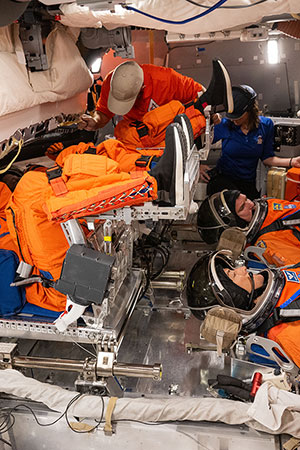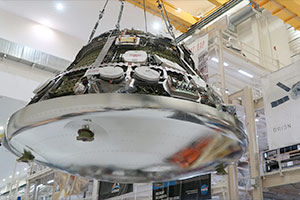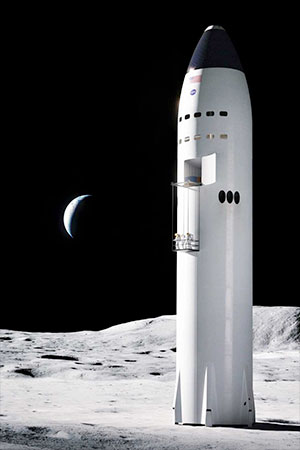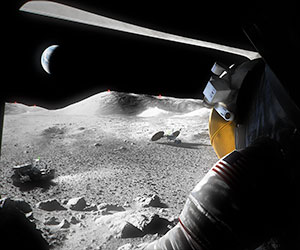January 9, 2024 — NASA has delayed the return of astronauts to the moon to address engineering issues and provide more time for the development of new vehicles and equipment.
The space agency had been targeting no earlier than November of this year for the launch of Artemis II carrying a four-person crew around the moon on a shakeout cruise for the Orion spacecraft. That mission is now expected to fly in September 2025, after teams at NASA and Lockheed Martin resolve known problems with the capsule's batteries and life support system, as well as gain a better understanding of the loss of part of the heat shield on an earlier test flight.
NASA astronauts Reid Wiseman, Victor Glover and Christina Koch, along with Jeremy Hansen of the Canadian Space Agency, remain assigned as the Artemis II crew and will continue their training through the nearly yearlong delay.
Separately, NASA also pushed back Artemis III, its first mission to land astronauts on the moon since the Apollo program did so more than 50 years ago, from late 2025 to September 2026. The delay acknowledges development challenges that have been experienced by NASA's commercial partners, including SpaceX for the human landing system and Axiom Space for next-generation lunar spacesuits.
"Safety is our top priority and to give the Artemis teams more time to work through the challenges with first time development, operations and integration, we're going to give more time for Artemis II and III," said Bill Nelson, NASA Administrator, in a call with reporters on Tuesday (Jan. 9). "Though challenges are clearly ahead, our teams are making incredible progress."
Future Artemis missions remain on track. Artemis IV continues to be targeted for 2028 on the first flight to the Gateway lunar orbit space station. Launch of the Gateway's first integrated elements, which had been planned for October 2025, is now under review to better align with Artemis IV.
'A realistic plan'
As the first flight with a crew on board the Orion spacecraft, the Artemis II mission will test critical environmental control and life support systems required to support the astronauts.
During the acceptance of some components for Artemis III, a failure was found in some of the motor valve circuitry that drive belts on the spacecraft. The same set of hardware had passed testing for Artemis II.
"When we examined them, we recognized that there was a design flaw," said Amit Kshatriya, deputy associate administrator for NASA's Moon to Mars program. "Those valve electronics affect many parts of the life support system, in particular, our CO2 [carbon dioxide] scrubbing system."
"We looked at the rationale for using the system as is, but it became very clear to us that it was unacceptable," he said. "We have to replace [the hardware] in order to guarantee the safety of the crew."
Accessing that system inside the Artemis II spacecraft is going to take time as every connector touched as part of the process will need to be retested and once complete the whole vehicle will have to go through functional testing.
Concurrently, NASA is also investigating a concern with some of the spacecraft's batteries and their ability to survive an inflight orbit. As part of qualifying the abort system on Artemis II, a few cases were found where it is believed there could be some deficiencies in the performance of the batteries.
"We're still very early in that investigation. We've not yet developed a forward path. We have multiple parallel options to fix this issue," said Kshatriya.
Lastly, while inspecting the heat shield from the Artemis I uncrewed test flight that returned to Earth from beyond the moon in late 2022, there was an unexpected loss of char layer pieces. This issue not so much a safety concern as it is one of understanding why it occurred.
"We just want to make sure that we understand why our modeling didn't predict it and do we have accurate modeling for the missions going forward," said Tonya Ladwig, vice president for human space exploration and Orion Program manager at Lockheed Martin.
NASA feels confident that it can address these issues given the time it now has for the Artemis II mission to launch.
"The [crew] wanted to see a realistic plan because they feel like that gives them the best path to people working to a realistic schedule. And that's what we've tried to put in place," said Jim Free, NASA's Associate Administrator.
'Methodical progress'
"For Artemis III, we must be realistic there as well," said Free.
To land astronauts on the moon and do so at the lunar south pole for the first time requires new capabilities, some of which are taking longer to develop.
NASA's chosen human landing system for the Artemis III mission is a version of SpaceX's Starship, which has a complex propellant transfer and Earth departure scheme that still needs to be tested. Axiom Space is developing new spacesuits for the astronauts to wear on the lunar surface. And a new docking system needs to be added to Orion so that it can link with Starship once both are in lunar orbit.
"No single one of [these] is more important than the other. We need them all to be ready in order to be successful for this complicated mission to come together," said Kshatriya. "This new schedule will give our [industry] partners the additional time to make refinements to make sure we're as successful as possible."
The new timeline for Artemis III also aligns with the updated schedule for Artemis II, ensuring that NASA can incorporate the lessons learned from Artemis II into the next mission.
"We're working on all these missions essentially simultaneously," said Free. "We need flexibility in our manifest. We need resilience in our manifest. And that is the commitment that we have from all of our NASA programs and all of our partners."
"It is essential that we make progress on every every element of the campaign in order to deliver on the success of these goals. It's also essential that we're prudent in the way we're planning for when these developments maybe have more issues, so that we are ready to respond in a flexible way and to make methodical progress towards our goals," he said. |
|

All dressed up and no where to go: The Artemis II crew, seen here training to exit their Orion spacecraft, now have an additional year before they fly to the moon. (NASA/James Blair)

The Orion spacecraft that will launch on NASA's Artemis II mission is moved in the Armstrong Operations and Checkout Building at the Kennedy Space Center, October 2023. (NASA/Amanda Stevenson)

Artist rendering of SpaceX's Starship human landing system (HLS) as NASA plans to use for the Artemis III moon mission. (SpaceX)

Illustration of an Artemis astronaut looking out of a hatch across the moon's surface, a lunar terrain vehicle and other elements. (NASA) |
